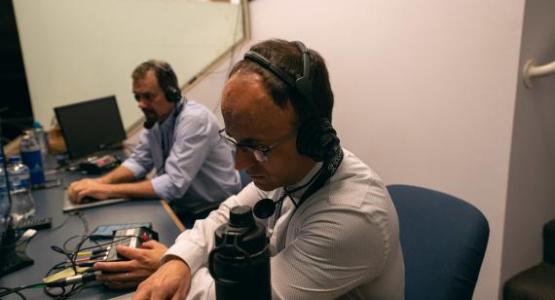
One Church, Many Languages
Debbie Michel, Adventist Review
As you exit the elevator on the fifth floor of the Dome at America’s Center in St. Louis, a sign reads “Broadcast Media.” The area that was once home to sports reporters is transformed for the week of the 61st General Conference Session into a space for interpreters to listen to the Session and relay each presentation continuously to those not able to understand English.
Simultaneous interpreters play one of the key roles in a Session communicating to a global church. According to the General Conference Office of Archives, Statistics and Research, more than 500 languages are used in Adventist publications. So it seems only fitting that a global church established in more than 200 countries would devote resources and effort to these international members.
Longtime interpreters coordinator Odette Ferreira retired at the end of the 2015 session, so the responsibility has now fallen to British Columbia pastor Roger Esteves. He receives significant assistance from General Conference treasury staff member Theophile Voilquin. Together they are coordinating a group of 45 translators in eight languages: Korean, Chinese, German, Romanian, Russian, Portuguese, French, and Spanish. Many are church employees, but a good portion of the interpreters are volunteers who took vacation from their private or public sector jobs, including one who’s a professional interpreter for the United Nations.
Hard Work
For the uninitiated, the job of simultaneous translating may look easy. But it’s far from it.
Esther Val Bonzil of Canada, who interprets from English to French, explains: “It requires for your mind to hear at the same time as you process the information, and then turning it into another language that you speak, while at the same time listening to the next sentence.”
To alleviate some of the burden of trying to figure out the speaker’s words on the fly, advance copies of presentations are sometimes available. But since that’s not always the case, working in shifts is recommended to give the brain a break. Esteves has organized the group so that interpreters are paired together and are encouraged to take turns working for 30 minutes at a time. But he allows flexibility. For instance, when there’s a video presentation, the Portuguese interpreters enjoy working together by alternating voices for the various speakers.
But there’s one interpreter who doesn’t have the luxury of a teammate. Marius Andrei is the only Romanian translator, and so far he seems to be doing fine. He says he never received formal training in learning English and considers his ability to speak the language a gift from God. While it’s not easy conducting simultaneous translation for upwards of 12 hours a day, by God’s grace he presses on. “It’s not easy for the delegates to stay in the [dome] and listen to all the explanations and vote all the time, so I’m doing the same thing,” he surmises. He also has a choice. “If I cannot do it anymore, I will take a break and start again.”
- Click here to watch a livestream of the meetings, scheduled to be livestreamed June 6-11.
- Among the expected 2,713 delegates, 21 will represent the Columbia Union Conference.
- Members from around the world are invited to attend a virtual exhibition hall.
- Just how does the session work? Find out more about the nominating committee process here.
- Visit Adventist Review, Adventist News Network and the Columbia Union Visitor Websites and social media accounts (Facebook and Twitter) for the latest news from the event.
News Stories from #GCSession
- Ted N.C. Wilson Re-Elected as President of the General Conference of Seventh-day Adventists for Third Term
- Twenty-One Delegates to Represent Columbia Union at GC Session
- World Church President Delivers Ministry Highlights and Significant Achievements Over Past Seven Year
- What Happened Today- Monday at the General Conference Session
- What Happened Today- Tuesday at the General Conference Session
- What Happened Today- Wednesday at the General Conference Session
- I Will Go Ride Comes to St. Louis
- Mission a Strong Focus of Secretariat’s Report at GC Session
- Erton Köhler Re-elected Executive Secretary
- Paul Douglas Elected as Treasurer of the Seventh-day Adventist Church
- Andersson and Valentine Join new General Vice President Team
- Delegates Approve Church Manual Amendment on Ordination of Elders
- G. Alexander Bryant Elected President of the Seventh-day Adventist Church in North America
- Elected Leaders Include New Faces on Well-Established Teams

Add new comment